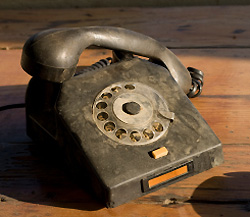
Luckily when designing a phone patch you do not have to worry much about what the telephone line looks like when the phone is on-hook.
This is good because while described as a 600-ohm balanced line, the on-hook line (the off-hook line is quite different, and will be discussed next) never measures 600 ohms, nor is it very well balanced.
Variations from 500-2500 ohms are reported for the ungrounded side of the line, simultaneous with the grounded side measuring 0-700 ohms hardly a balanced line.
Plus the DC resistance of the telephone cabling is not trivial, easily amounting to as much as 1500 ohms for locations a few miles from the central office (26 AWG is common, measuring 440 ohms/mile).
Once the phone is answered, the system goes into off-hook mode and sends out the dial tone. Now the line is predictable with the balanced output impedance measuring about 400 ohms (±25%), split evenly between the two lines, with the voltage ranging from 42 volts to as high as 80 volts. Still not well balanced, but a lot closer than the on-hook values.
The back-to-back zener diodes in the secondary clamp any high voltage (including any ring voltage that may appear) that gets through the transformer and protects the downstream equipment. Their value is pretty arbitrary and is determined by what the interfaced unit can withstand. The 1N746s limit the output to 4 volts peak-to-peak, or 1.4 Vrms.
Likewise the power rating need not be excessive; 1/2-watt is enough.
Circuit Summary
1. Provide isolation (transformer).
2. Block DC voltage (series capacitor).
3. If required, provide DC path to hold the line (parallel resistor).
4. Provide primary protection (parallel MOV)
5. Provide secondary protection (zener diodes).
6. Protect against too low secondary impedance (series resistor).
DIY (do-it-yourself) Transformer Sources
Telephony has been around for so long that most electronic supply stores carry interfacing transformers (600 ohm to 600 ohm, analog audio transformer with telephone grade frequency response and distortion performance).
They come in two types: “wet” and “dry,” referring to whether they are designed to pass direct current (DC) wet transformers withstand DC currents without saturating, dry transformers do not. For the diagram shown you want a dry transformer, which is smaller and less expensive than wet ones. Most modern telephone circuits use dry transformers.
Three shown, but typical of many:
* Bourns Cat. # LM-LP 1001 (thru-hole) or SM-LP-5001 (SMT)
* Radio Shack Cat. # 273-1374 (wire leads)
* Tamura Cat. # MET-46 (thru-hole)
* Other good sources include Prem Magnetics and Midcom
Store-Bought Phone Patch Sources
The following are simple telephone interfaces. They are not hybrids. They are used simply to put audio on or take audio off POTS. They are not for teleconferencing and will not work due to their lack of acoustic echo cancelling technology. These are for non-conference applications only.
The models differ greatly in features and price, so do your homework before spending momma’s hard-earned money.
* Comrex Telephone Coupler TCB-2
* Excalibur HC-1 Handi-Coupler
* PSC Phone Tap
* Radio Shack
Presented with permission from Rane Corporation.
